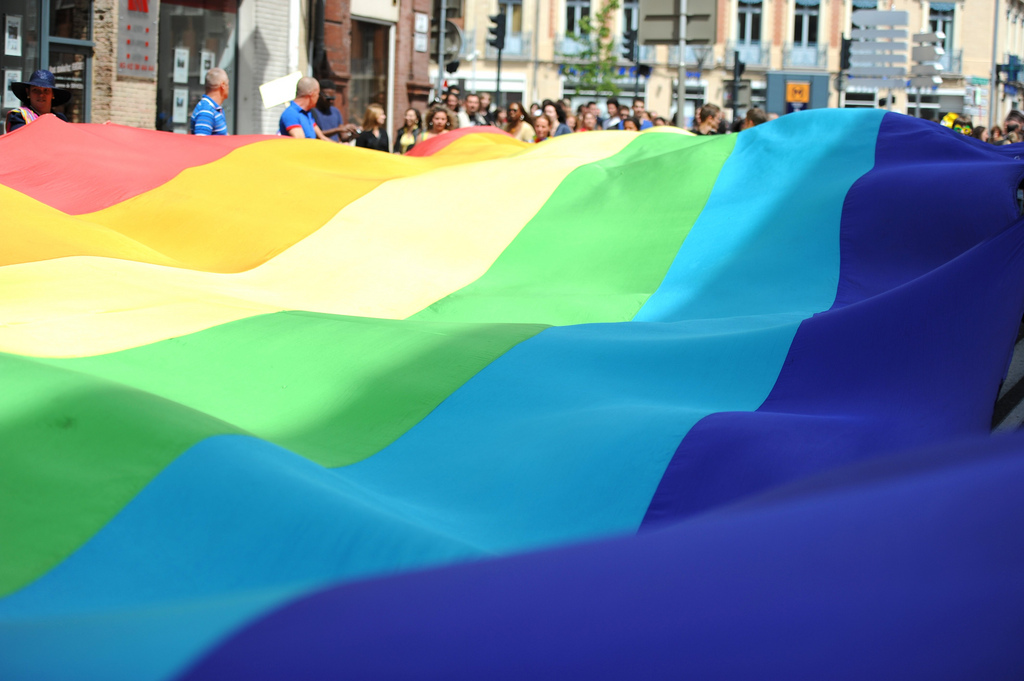aNewDomain — In a landmark 5-4 decision on June 26, 2015 the Supreme Court ruled that the Fourteenth Amendment of the Constitution guarantees marriage equality for same-sex couples. Justice Kennedy wrote the majority opinion — which is a lovely piece of writing — while the four dissenting Justices each opted to pen their own responses.
 I want to pause for a moment to recognize the positive step SCOTUS (Supreme Court of the United States) has taken today. It’s easy to become overwhelmed with feelings that the U.S. will never reach any level of equality or equity, and that those who are discriminated against will remain second-class citizens. Moments like this are a chance for many to finally feel seen, that their struggles have not been in vain, and that equal constitutional rights are actually achievable.
I want to pause for a moment to recognize the positive step SCOTUS (Supreme Court of the United States) has taken today. It’s easy to become overwhelmed with feelings that the U.S. will never reach any level of equality or equity, and that those who are discriminated against will remain second-class citizens. Moments like this are a chance for many to finally feel seen, that their struggles have not been in vain, and that equal constitutional rights are actually achievable.
A multitude of rainbows and exuberance has turned my Facebook feed into a veritable pride parade. But there are occasional sobering comments that bring my focus back to the work we still have left ahead of us.
There is great value in today’s SCOTUS decision, but there are also many things that worry me. Here are three:
People Might Think The Fight Is Over
Many queer-rights organizations have prioritized their energy — and finances — on achieving the very specific aim of marriage equality. With such emphasis and public focus on this one issue (and the exclusion of many others) it may look like this ruling checks a box on the proverbial list and the issue is now resolved.
I find myself thinking of the civil rights movement in the U.S. in the 1960s. Some legal protections were established for minorities with the Voting Rights Act and Civil Rights Act, and today many people sit comfortably with the idea that with regard to race, all people in our country are treated equally.
The reality, though, is that there are many places in the U.S. where it’s not safe for a black man to walk down the street in his hometown without fear of reprisal from the people who are supposed to keep him safe.
Perhaps nowhere is the picture of inequity more clear than in the current state of our prison system. Today more than 60 percent of the people in prison are people of color, and black men are six times more likely to be incarcerated than white men. Yet many ignore the profound evidence around them and state that we no longer need race-based protections like affirmative action.
 Have we solved the issue of racism in America? Absolutely not. Only if we recognize the fight is not over will we keep moving toward racial equality and equity in this country. The same is true as we continue the work toward equity for people regardless of sexual orientation, gender identity and gender expression.
Have we solved the issue of racism in America? Absolutely not. Only if we recognize the fight is not over will we keep moving toward racial equality and equity in this country. The same is true as we continue the work toward equity for people regardless of sexual orientation, gender identity and gender expression.
Today’s SCOTUS decision will hopefully be one of many actions to move us in the right direction, but it definitely isn’t the end of this fight.
Human Rights Are So Much More Than Marriage Equality
The legal right for same sex couples to marry is only one small piece of a much larger puzzle. It’s impossible to consider just one “-ism,” in this case heterosexism, in isolation. It’s much more comfortable to look at the marriage equality issue by itself than it is to examine the other biases and privileges at play in our society that contribute to our current system of inequity.
The Human Rights Campaign, one of the largest proponents of the marriage equality movement, has been widely criticized for claiming their work “focuses on promoting the social welfare of lesbian, gay, bisexual, and transgender (LGBT) people,” while ignoring, misrepresenting and in some cases actively oppressing members of the LGBT community.
In 2007, the HRC supported an employment anti-discrimination bill that would have made it illegal for companies to discriminate against gays, lesbians and bisexuals, but left trans people completely out of the protections. In 2014 the HRC publicly apologized for their underrepresentation of trans people, but for many the words were too little, too late.
The HRC has often focused narrowly on one topic like marriage equality while actively ignoring complex issues of far greater consequence. If we ignore the intersectionality of oppressions — racism, sexism, heterosexism, ableism and so many more — and we continue to pretend that privilege among the dominant groups is something out of fiction, we are not really making progress toward an equal or equitable society.
The Fight for Survival
The hyper-focus on achieving this one specific right has allowed many other needs to fall by the wayside. Suicide is the second leading cause of death among young people aged 10-24. Lesbian, gay and bisexual youth are four times more likely to attempt suicide than their straight peers. Almost half of young transgender people have seriously thought about committing suicide and 25 percent report having made at least one attempt.
I spent four years serving on the board of the statewide non-profit organization Outright Vermont, which seeks to build safe, healthy, and supportive environments for gay, lesbian, bisexual, transgender, queer and questioning youth (ages 13-22). From the outside, Vermont appears to be a liberal bastion, a place where things like homophobia have no space between the pot-smoking hippies and the organic vegetable gardeners. While there are wonderful aspects of life in Vermont, it’s not quite the queer haven some believe it to be.
LGB youth in Vermont are twice as likely to have been bullied in the past month than their straight peers (36 percent and 16 percent, respectively). LGB youth are four times as likely to have skipped school at least once in the past month because they felt unsafe (16 precent and four percent, respectively). Most alarmingly, LGB youth are six times more likely to have attempted suicide in the past year than their straight peers (19 percent and three percent, respectively).
Even in a small and apparently liberal-minded state like Vermont, our youth are still at high risk for self harm and harm from others simply because of their sexual orientation, gender identity and/or gender expression.
With so many young people fighting simply to survive, I believe it’s misguided to focus so much of our collective adult attention on personal rights like marriage equality to the exclusion of children and youth that need our energy, activism and money to help them survive.
What’s Next?
It’s important that we continue working toward a just and equitable society and that we don’t let successes like this one allow us to get complacent. The challenges we face are large and difficult, but if we continue learning about our complicated history as a nation and we work together to address the intersecting oppressions many of us face on a daily basis, we can make progress.
Against Equality, an online archive, publishing, and arts collective focused on critiquing mainstream gay and lesbian politics, uses a symbol that closely resembles the logo of the Human Rights Campaign. But in place of the equal sign they use a “greater than” sign. When asked about his design, co-founder Ryan Conrad said,
Why settle for mere equality when we could have a better, more just, and more equitable world rather than an equal stake in today’s deeply inequitable and harmful institutes?”
 Mattilda Berstein Sycamore, a contributor to the AE site, said, “When did our dreams get so small? We must envision and fight for a future far greater than the confines inclusion provide.”
Mattilda Berstein Sycamore, a contributor to the AE site, said, “When did our dreams get so small? We must envision and fight for a future far greater than the confines inclusion provide.”
For aNewDomain, I’m Becket Morgan.
Images in order: Gay Pride Flag by Guillaume Paumier via Flickr; Victory courtesy of HRC; Greater Than logo courtesy of Against Equality














Bullet point #1. Well said.
-RAP, II
That’s limited thinking. Yes, people shouldn’t give up the fight. But who’s to say they have, and with information like this that’s pessimistic, it’s sure not helpful. — Gary Erwin via LinkedIn
This is an awesome piece, Becket. Best piece I read on this thing all day.